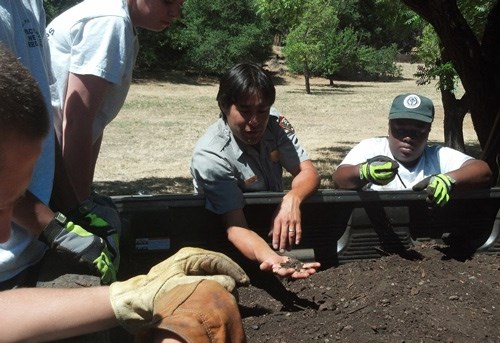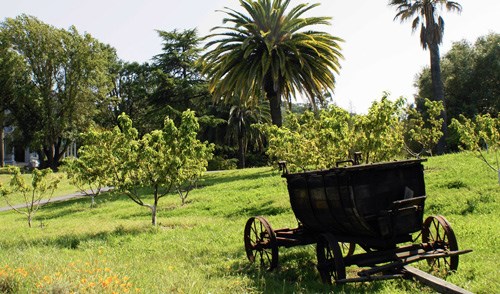Case Study: John Muir National Historic Site
Martinez, CA
The Goal
To retain nutrient-rich organic material on-site and divert landscape debris from landfills.
Set in the Alhambra Valley, John Muir National Historic Site is one of few remaining fruit ranches in a region once dominated by agricultural production. The gardens and managed agricultural lands associated with Muir’s high-style Victorian home and the Martinez Adobe (9 acres), Mount Wanda’s wooded hillsides and remote grasslands (326 acres), and the streamside setting of the Strentzel-Muir gravesite (1 acre) provide a portrait of the once sprawling 3,200-acre Strentzel-Muir Ranch.

NPS Photo
The Solutions
Healthy soil is a catalyst for many factors that promote the resilience of cultural landscapes. Nutrient rich soils promote vegetation health by making nutrients available to plants and encouraging root hair growth. Microbial activity in compost promotes balanced soil ecology by keeping harmful microbes and organisms in check. Mulching reduces evaporation rates and the need for landscape irrigation.
At John Muir National Historic Site, park staff, volunteers, and Youth Conservation Corp members add landscape debris to compost piles on an ongoing basis. With collection bins in park lunchrooms, food waste is also collected for compost piles. Offsite landscape materials are not added to the compost piles, ensuring a closed system.

NPS Photo
During the two-week establishment period, compost piles are monitored for moisture and temperature and turned by tractor every three days. Following establishment, compost piles are monitored and turned monthly. Exothermic activity is necessary to support the break-down of landscape debris and kill weed seeds. In the event of low ambient temperature, compost piles are solarized by covering with black plastic.
Ample space is also a significant requirement for a successful compositing operation, with each compost pile occupying upwards of 500 square feet. Turning comparably sized piles requires up to a 4,000 square-foot work area for tractor maneuvering. Finished compost is hand screened through a custom-built 1” x ½” mesh screen placed over an eight-foot pickup truck bed.
Increasingly, the composting program at John Muir National Historic Site engages park volunteers to help build, monitor, and distribute compost. Park staff is also evaluating opportunities to interpret the composting program for visitors. Demonstrations allow green practices to be shared beyond park boundaries, and with the John Muir National Historic Site compost operation generating more finished material than can be used on site, excess material is made available to park volunteers and staff.
Additional Information
John Muir National Historic Site is committed to reducing energy consumption and conserving resources across all departments, not only in the landscape. Upgrading light bulbs and monitoring thermostat settings in buildings has yielded energy savings, and a recently installed real-time energy monitoring system enables the park facility manager to target additional efficiencies.
In 2008, a patch of lawn in front of the visitor center was converted to a California native plant garden to demonstrate the utility, efficiency, and beauty of native perennials and to promote the removal of water inefficient turf. In 2010, the garden was expanded to create a native bunch grass meadow in the narrow strips surrounding the visitor parking area. For most of its irrigation needs John Muir National Historic Site maintains two original, historic water wells and has drawn from this renewable source for many years.
The orchards and grounds at John Muir National Historic Site are generally considered to be working landscapes, where maintenance activities and cultural practices are not necessarily hidden from public view. The composting project is a perfect example of this philosophy. We invite the public to ask questions about the operation in order to highlight the sustainability benefits of keeping green waste on site and returning it to the landscape to improve soil health and plant resiliency.
Questions about John Muir National Historic Site’s composting and grounds maintenance operations or how to join as a volunteer may be addressed to the John Muir National Historic Site.
Year: Ongoing, beginning in 2009
Treatment: Rehabilitation
Landscape Type: Designed, vernacular, and historic site
Measurable Benefits
Landscape debris diverted from landfills: 1,000 pounds/year*
Synthetic fertilizer savings: 300 pounds/year**
*Figure estimated based on John Muir NHS Sustainable Practices Report (2012).
**Figure estimated based on comparison with industry standard practices.

Services Provided
- Food supply improvement
- Biodiversity/habitat protection and enhancement
- Recreational/visible green space enhancement
- Enhanced resilience to withstand change
- Pest Control
- Soil enrichment
NPS Green Parks Plan Features
- Continuously Improve Environmental Performance
- Be Energy Smart
- Be Water Wise
- Reduce, Reuse, and Recycle
- Preserve Outdoor Values
- Adopt Best Practices
- Foster Sustainability Beyond Our Boundaries

- Two parts brown material (carbon) to one part green material (nitrogen)
- Ideal for use with woody plants
- Two parts green material to one part brown material
- Ideal for use with herbaceous vegetation and turf
Compost Uses
Mulch: Spread on planting beds to improve soil fertility and plant health, and reduce evaporation rates
Loam (screened): Used when planting to improve soil fertility, plant health, and water retention
Compost: Spread as fertilizer to improve soil fertility and plant health
Compost Tea: Liquid extract from compost, sprayed to improve soil fertility and plant health
Last updated: April 28, 2022





